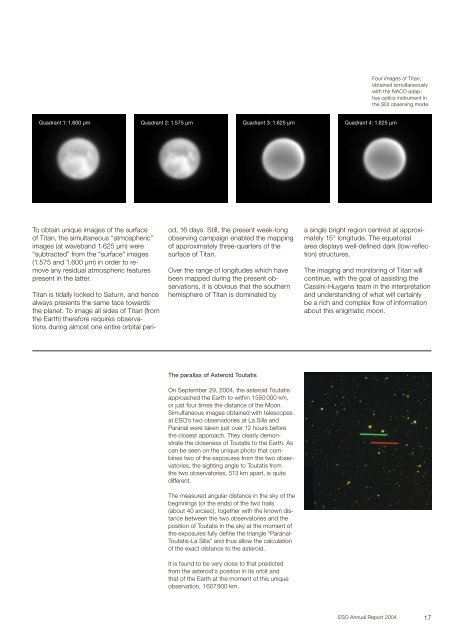ESO Annual Report 2004
ESO Annual Report 2004
ESO Annual Report 2004
- TAGS
- annual
- www.eso.org
You also want an ePaper? Increase the reach of your titles
YUMPU automatically turns print PDFs into web optimized ePapers that Google loves.
Quadrant 1: 1.600 µm Quadrant 2: 1.575 µm Quadrant 3: 1.625 µm Quadrant 4: 1.625 µm<br />
To obtain unique images of the surface<br />
of Titan, the simultaneous “atmospheric”<br />
images (at waveband 1.625 µm) were<br />
“subtracted” from the “surface” images<br />
(1.575 and 1.600 µm) in order to remove<br />
any residual atmospheric features<br />
present in the latter.<br />
Titan is tidally locked to Saturn, and hence<br />
always presents the same face towards<br />
the planet. To image all sides of Titan (from<br />
the Earth) therefore requires observations<br />
during almost one entire orbital peri-<br />
od, 16 days. Still, the present week-long<br />
observing campaign enabled the mapping<br />
of approximately three-quarters of the<br />
surface of Titan.<br />
Over the range of longitudes which have<br />
been mapped during the present observations,<br />
it is obvious that the southern<br />
hemisphere of Titan is dominated by<br />
The parallax of Asteroid Toutatis<br />
On September 29, <strong>2004</strong>, the asteroid Toutatis<br />
approached the Earth to within 1550 000 km,<br />
or just four times the distance of the Moon.<br />
Simultaneous images obtained with telescopes<br />
at <strong>ESO</strong>’s two observatories at La Silla and<br />
Paranal were taken just over 12 hours before<br />
the closest approach. They clearly demonstrate<br />
the closeness of Toutatis to the Earth. As<br />
can be seen on the unique photo that combines<br />
two of the exposures from the two observatories,<br />
the sighting angle to Toutatis from<br />
the two observatories, 513 km apart, is quite<br />
different.<br />
The measured angular distance in the sky of the<br />
beginnings (or the ends) of the two trails<br />
(about 40 arcsec), together with the known distance<br />
between the two observatories and the<br />
position of Toutatis in the sky at the moment of<br />
the exposures fully define the triangle “Paranal-<br />
Toutatis-La Silla” and thus allow the calculation<br />
of the exact distance to the asteroid.<br />
It is found to be very close to that predicted<br />
from the asteroid's position in its orbit and<br />
that of the Earth at the moment of this unique<br />
observation, 1607900 km.<br />
a single bright region centred at approximately<br />
15° longitude. The equatorial<br />
area displays well-defined dark (low-reflection)<br />
structures.<br />
The imaging and monitoring of Titan will<br />
continue, with the goal of assisting the<br />
Cassini-Huygens team in the interpretation<br />
and understanding of what will certainly<br />
be a rich and complex flow of information<br />
about this enigmatic moon.<br />
<strong>ESO</strong> <strong>Annual</strong> <strong>Report</strong> <strong>2004</strong><br />
Four images of Titan,<br />
obtained simultaneously<br />
with the NACO adaptive<br />
optics instrument in<br />
the SDI observing mode.<br />
17

















